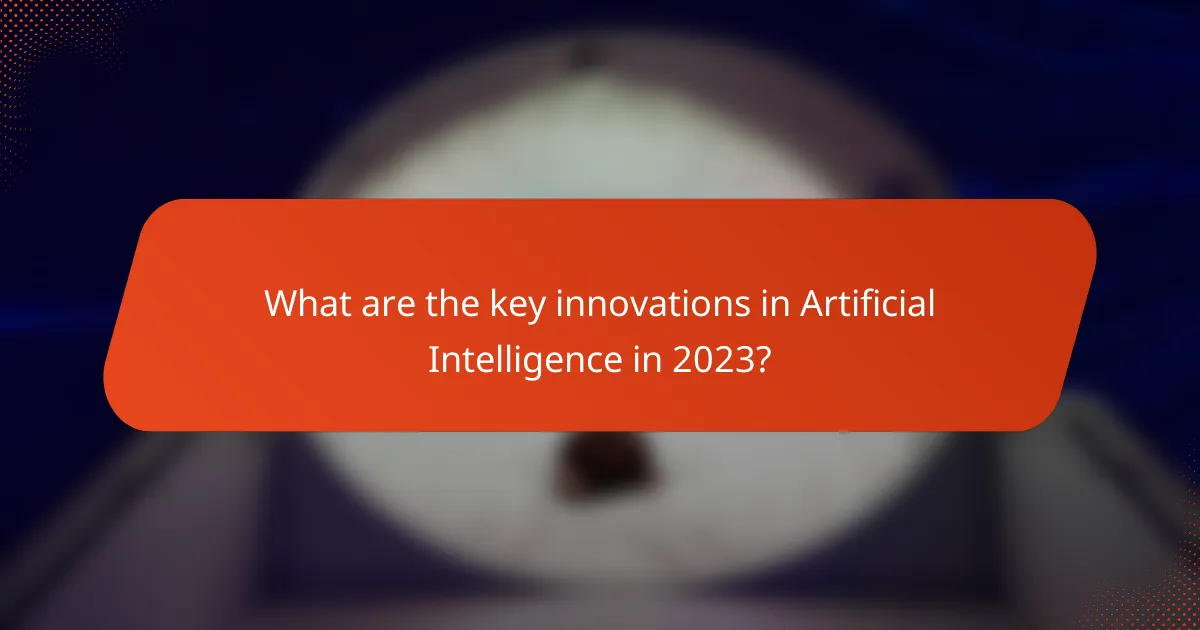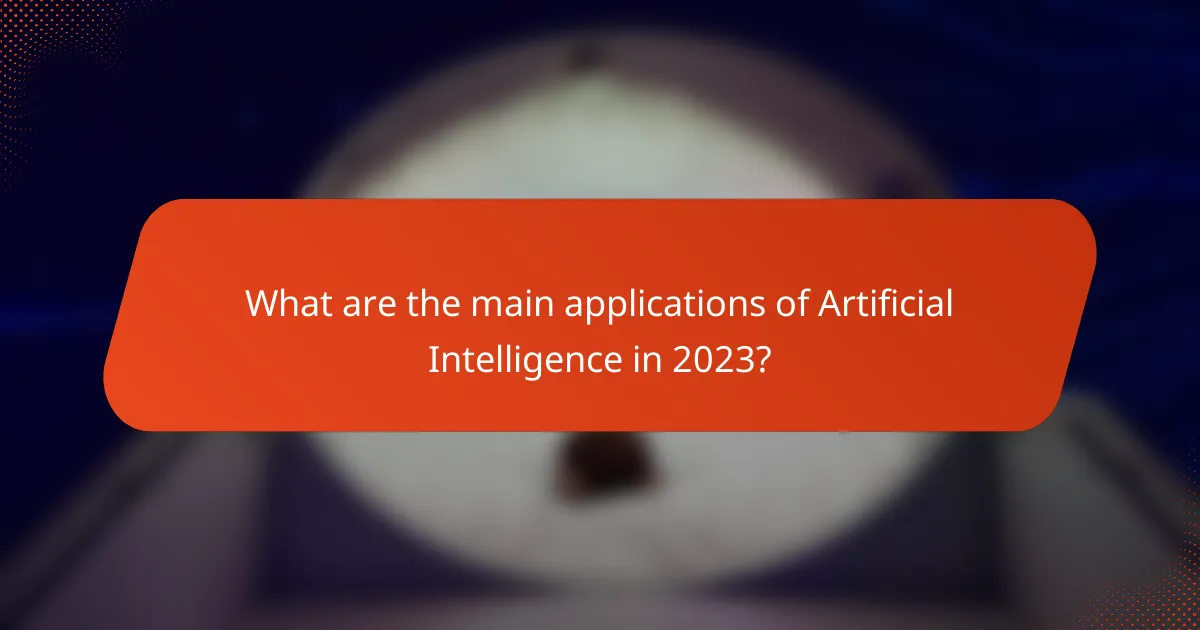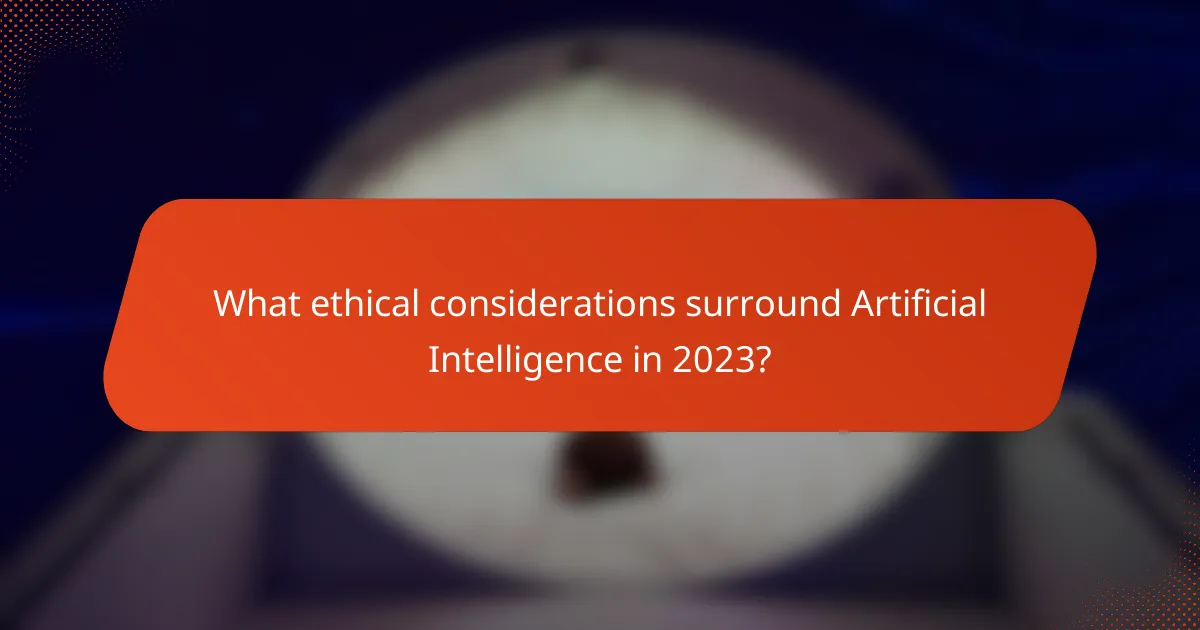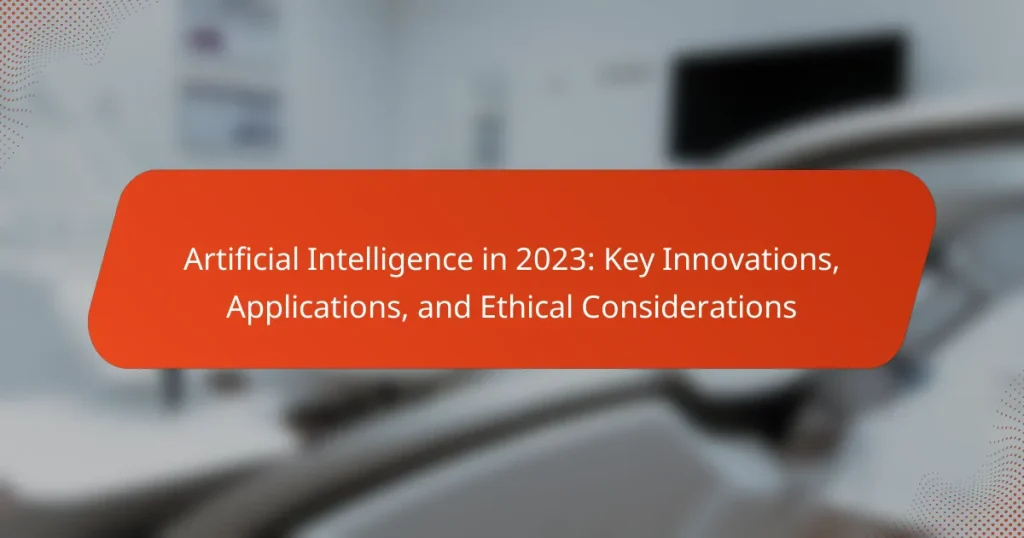Artificial Intelligence (AI) in 2023 has witnessed significant innovations, particularly in generative AI, natural language processing, and machine learning algorithms. Key advancements include the development of sophisticated generative models such as ChatGPT and DALL-E, which produce high-quality text and images, and breakthroughs in natural language processing that enhance contextual understanding. AI applications are prominently seen in sectors like healthcare, where it aids in disease diagnosis, finance for fraud detection, and autonomous vehicles for navigation. Ethical considerations surrounding AI include issues of bias, transparency, accountability, and privacy, particularly as AI systems increasingly handle sensitive data and impact employment dynamics.

What are the key innovations in Artificial Intelligence in 2023?
Key innovations in Artificial Intelligence in 2023 include advancements in generative AI, enhanced natural language processing, and improved machine learning algorithms. Generative AI models, like ChatGPT and DALL-E, have become more sophisticated, producing high-quality text and images. Natural language processing has seen breakthroughs, enabling more nuanced understanding of context and sentiment. These advancements are supported by increased computational power and more extensive datasets. Additionally, AI systems are integrating better with other technologies, enhancing automation and decision-making capabilities across industries. The deployment of AI in healthcare, finance, and customer service has also accelerated, showcasing its practical applications.
How have recent advancements transformed AI technologies?
Recent advancements have significantly transformed AI technologies by enhancing their capabilities and efficiency. Innovations in deep learning algorithms have improved the accuracy of AI models. For example, transformer architectures have enabled better natural language processing. Increased computational power has allowed for training on larger datasets. This has led to more sophisticated AI applications in various fields. In healthcare, AI now assists in diagnostics and personalized medicine. In finance, AI algorithms enhance fraud detection and risk assessment. These advancements demonstrate a shift towards more practical and impactful uses of AI technology.
What are the most significant breakthroughs in machine learning this year?
This year, significant breakthroughs in machine learning include advancements in large language models and reinforcement learning. OpenAI’s GPT-4 has shown improved understanding and generation of human-like text. It can now process images alongside text, enhancing multimodal capabilities. Google’s PaLM 2 has demonstrated state-of-the-art performance in reasoning tasks. Reinforcement learning has also progressed with DeepMind’s advancements in AI training efficiency. These breakthroughs have been validated by various benchmarks and competitions, showcasing their effectiveness in real-world applications.
How has natural language processing evolved in 2023?
Natural language processing has significantly advanced in 2023. Key developments include improved contextual understanding and more accurate sentiment analysis. Models have become more efficient, requiring less computational power. Enhanced training datasets have led to better performance in diverse languages. Real-time translation capabilities have also improved, facilitating global communication. Additionally, ethical frameworks have been established to address biases in AI. Research indicates that user trust in AI has increased due to transparency initiatives. These advancements reflect a broader trend towards more responsible AI deployment in various applications.
What role does deep learning play in AI innovations?
Deep learning is a critical component of AI innovations. It enables machines to learn from vast amounts of data. This learning process mimics human brain function through neural networks. Deep learning algorithms improve tasks such as image and speech recognition. They achieve high accuracy rates, making them valuable in various applications. For instance, deep learning powers advancements in autonomous vehicles and healthcare diagnostics. Research shows that deep learning models outperform traditional algorithms in many benchmarks. This effectiveness drives ongoing investment and development in AI technologies.
How is deep learning being applied in various sectors?
Deep learning is being applied in various sectors such as healthcare, finance, and automotive. In healthcare, it aids in medical imaging analysis and predictive diagnostics. For instance, deep learning algorithms can detect anomalies in X-rays and MRIs with high accuracy. In finance, it is used for fraud detection and algorithmic trading. Deep learning models analyze transaction patterns to identify suspicious activities. In the automotive sector, deep learning powers autonomous vehicles. These vehicles utilize neural networks for object detection and navigation. Furthermore, in retail, deep learning enhances customer experience through personalized recommendations. Overall, deep learning’s applications are vast and transformative across multiple industries.
What challenges does deep learning face in 2023?
Deep learning faces several challenges in 2023. One major challenge is the need for large amounts of labeled data. Acquiring and annotating this data can be time-consuming and expensive. Another challenge is the high computational cost associated with training deep learning models. This often requires specialized hardware and significant energy consumption. Additionally, deep learning models can suffer from overfitting, especially when trained on small datasets. Interpretability remains a significant issue, as many models operate as “black boxes.” This lack of transparency can hinder trust and adoption in critical applications. Lastly, ethical considerations around bias in training data continue to pose challenges. These issues can impact the fairness and reliability of deep learning systems.

What are the main applications of Artificial Intelligence in 2023?
The main applications of Artificial Intelligence in 2023 include healthcare, finance, and autonomous vehicles. In healthcare, AI assists in diagnosing diseases and personalizing treatment plans. For instance, AI algorithms analyze medical images to detect conditions like cancer early. In finance, AI improves fraud detection and automates trading processes. AI systems analyze transaction patterns to identify suspicious activities. Autonomous vehicles utilize AI for navigation and decision-making. These vehicles rely on AI to interpret sensor data and ensure safe driving. Additionally, AI is prevalent in customer service through chatbots and virtual assistants. These applications enhance efficiency and user experience across various sectors.
How is AI being utilized in healthcare?
AI is utilized in healthcare for diagnostics, treatment recommendations, and patient management. Machine learning algorithms analyze medical data to identify patterns. These patterns help in diagnosing diseases more accurately. AI assists in personalizing treatment plans based on patient data. Natural language processing enables efficient handling of patient records. AI-driven tools improve operational efficiency in hospitals. Studies show AI can reduce diagnostic errors by up to 20%. AI applications are transforming patient care and operational workflows in healthcare settings.
What specific AI technologies are improving patient outcomes?
Machine learning algorithms are improving patient outcomes by analyzing vast amounts of healthcare data. These algorithms help in predicting disease outbreaks and patient deterioration. Natural language processing (NLP) is utilized to interpret unstructured clinical notes. This technology enhances communication between healthcare providers and patients. Computer vision is applied in radiology to detect anomalies in medical images. Studies show that AI can outperform human radiologists in identifying certain conditions. Predictive analytics tools assess patient risks and personalize treatment plans. These technologies collectively contribute to more accurate diagnoses and tailored therapies.
How is AI impacting medical research and drug development?
AI is significantly impacting medical research and drug development by enhancing data analysis and accelerating discovery processes. Machine learning algorithms analyze vast datasets to identify patterns and potential drug candidates. For instance, AI can predict how different compounds will interact with biological systems. This capability reduces the time needed for preclinical testing. In 2020, AI-driven drug discovery led to the identification of a potential COVID-19 treatment in just weeks. Additionally, AI improves clinical trial design by optimizing patient selection and monitoring. According to a report by Frost & Sullivan, AI could save the pharmaceutical industry up to $100 billion annually by streamlining processes. These advancements demonstrate AI’s transformative role in making medical research more efficient and effective.
What are the implications of AI in business and industry?
AI significantly transforms business and industry by enhancing efficiency and decision-making. Automation of routine tasks reduces operational costs. AI-driven analytics provide insights for strategic planning. Personalized customer experiences increase satisfaction and loyalty. Predictive maintenance minimizes downtime in manufacturing. AI also fosters innovation by enabling new product development. According to McKinsey, AI could add $13 trillion to the global economy by 2030. These implications highlight the critical role of AI in shaping future business landscapes.
How are companies leveraging AI for operational efficiency?
Companies are leveraging AI for operational efficiency by automating routine tasks and optimizing workflows. Automation reduces human error and increases speed in processes. AI algorithms analyze large datasets to identify inefficiencies. This data-driven approach enables companies to make informed decisions. Predictive maintenance powered by AI minimizes downtime in manufacturing. AI-driven chatbots enhance customer service by providing instant support. Machine learning models predict market trends, allowing for proactive adjustments. Companies report significant cost savings and improved productivity through these AI applications.
What are the potential risks of AI in business applications?
The potential risks of AI in business applications include data privacy concerns, algorithmic bias, and job displacement. Data privacy concerns arise when sensitive information is processed without adequate protections. This can lead to breaches and loss of customer trust. Algorithmic bias occurs when AI systems make decisions based on flawed data or assumptions. This can result in unfair treatment of individuals or groups. Job displacement is a risk as automation replaces certain roles, leading to workforce challenges. According to a McKinsey report, up to 25% of jobs could be affected by automation by 2030. These risks necessitate careful management and ethical considerations in AI deployment.

What ethical considerations surround Artificial Intelligence in 2023?
Ethical considerations surrounding Artificial Intelligence in 2023 include bias, transparency, and accountability. AI systems can perpetuate bias if trained on skewed data. This raises concerns about fairness in decision-making processes. Transparency is crucial for understanding AI operations. Users need to know how decisions are made by these systems. Accountability is essential when AI causes harm or error. There must be clear responsibility for AI actions. Privacy issues also arise, as AI systems often process sensitive personal data. Compliance with regulations like GDPR is necessary to protect user information. The potential for job displacement due to automation is another ethical concern. This impacts economic stability and workforce dynamics.
Why is AI ethics becoming increasingly important?
AI ethics is becoming increasingly important due to the rapid integration of AI technologies into society. These technologies influence critical areas such as healthcare, finance, and law enforcement. Ethical considerations help prevent biases in AI algorithms that can lead to unfair treatment of individuals. For instance, studies have shown that AI systems can perpetuate racial and gender biases if not properly monitored. Furthermore, ethical guidelines ensure transparency in AI decision-making processes. This transparency builds public trust in AI systems. As AI continues to evolve, addressing ethical concerns will be essential for responsible innovation.
What are the main ethical dilemmas faced by AI developers?
AI developers face several main ethical dilemmas. These include bias in algorithms, which can lead to unfair outcomes. Data privacy is another critical concern, as AI systems often require vast amounts of personal information. Transparency in AI decision-making processes is also an issue. Developers must ensure users understand how decisions are made. Accountability for AI actions poses a challenge, especially when errors occur. The potential for job displacement due to automation raises ethical questions about economic impacts. Lastly, the misuse of AI technology for harmful purposes presents significant ethical risks. Each of these dilemmas requires careful consideration and responsible management by AI developers.
How do biases in AI algorithms affect outcomes?
Biases in AI algorithms can lead to skewed and unfair outcomes. These biases often arise from the data used to train the algorithms. If the training data is unrepresentative or contains historical prejudices, the AI may perpetuate these biases. For example, a study by ProPublica found that a risk assessment algorithm used in the criminal justice system disproportionately flagged black defendants as high risk. This demonstrates how biased data can result in discriminatory practices. Furthermore, biased AI outcomes can affect hiring decisions, loan approvals, and law enforcement actions. Addressing these biases is crucial for ensuring fairness and equity in AI applications.
What regulations are being proposed to govern AI use?
Proposed regulations to govern AI use include the European Union’s AI Act. This legislation aims to create a comprehensive framework for AI development and deployment. It categorizes AI systems based on risk levels, imposing stricter requirements on high-risk applications. The regulations emphasize transparency, accountability, and human oversight. Additionally, they require organizations to conduct impact assessments before deploying AI technologies. Similar discussions are occurring in various jurisdictions, including the United States and the United Kingdom. These efforts reflect a growing recognition of the need for ethical AI governance.
How do these regulations aim to address ethical concerns?
These regulations aim to address ethical concerns by establishing guidelines for responsible AI development and deployment. They focus on promoting transparency in AI systems. This includes clear documentation of algorithms and data usage. Regulations also emphasize fairness to prevent bias in AI outcomes. They require regular audits to ensure compliance with ethical standards. Additionally, they promote accountability by assigning responsibility for AI decisions. These measures are designed to protect user privacy and data security. Overall, the regulations seek to foster public trust in AI technologies.
What role do stakeholders play in shaping AI ethics?
Stakeholders play a crucial role in shaping AI ethics. They include developers, users, policymakers, and affected communities. Each group contributes unique perspectives on ethical considerations. Developers focus on technical feasibility and innovation. Users emphasize the practical implications of AI applications. Policymakers establish regulations and guidelines to ensure accountability. Affected communities voice concerns about potential harm and discrimination. Collaboration among these stakeholders fosters a comprehensive ethical framework. This framework can address issues like bias, privacy, and transparency in AI systems. Research indicates that diverse stakeholder engagement leads to more equitable AI outcomes. For example, the Partnership on AI emphasizes inclusive dialogue to enhance ethical standards in AI development.
What best practices can organizations adopt for ethical AI development?
Organizations can adopt several best practices for ethical AI development. First, they should implement transparency in AI systems. This involves clearly explaining how algorithms make decisions. Second, organizations must ensure fairness by addressing bias in data sets. This can be achieved through regular audits and diverse training data. Third, they should prioritize accountability by establishing clear lines of responsibility for AI outcomes. Fourth, organizations need to engage stakeholders in the development process. This includes gathering feedback from affected communities. Fifth, they should promote privacy by safeguarding user data and implementing robust security measures. Lastly, continuous monitoring and evaluation of AI systems are essential. This helps to identify and rectify ethical issues as they arise. These practices are supported by guidelines from organizations like the IEEE and the EU’s Ethical Guidelines for Trustworthy AI.
The main entity of the article is Artificial Intelligence (AI) in 2023, which encompasses key innovations, applications, and ethical considerations. The article outlines significant advancements in generative AI, natural language processing, and machine learning algorithms, highlighting their transformative impact across various sectors, including healthcare and finance. It also addresses the challenges and ethical dilemmas associated with AI technologies, such as bias, transparency, and accountability, while proposing regulations aimed at governing AI use. Additionally, the article emphasizes best practices for organizations to ensure responsible AI development and deployment.




